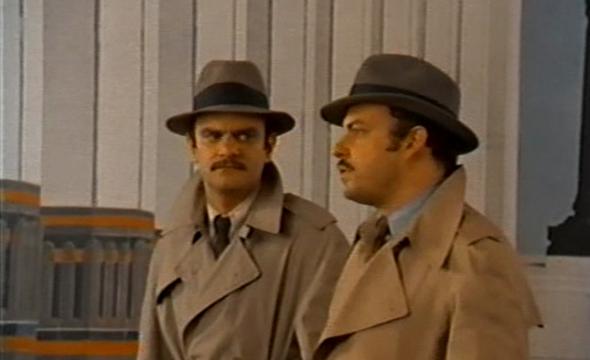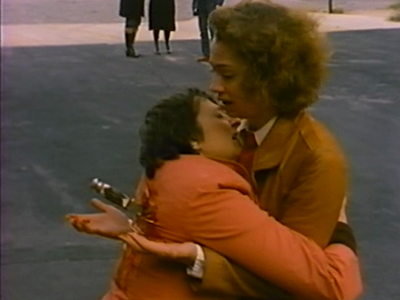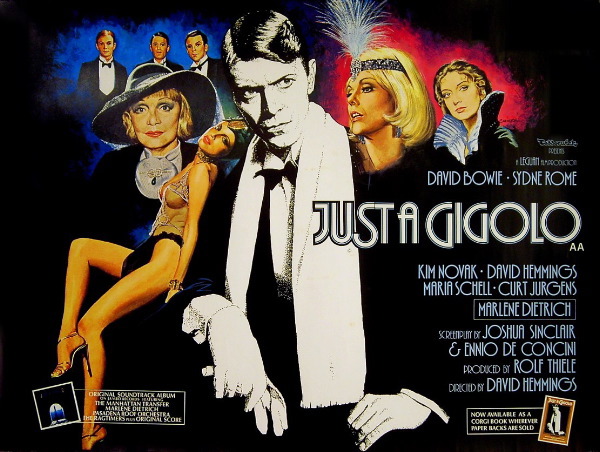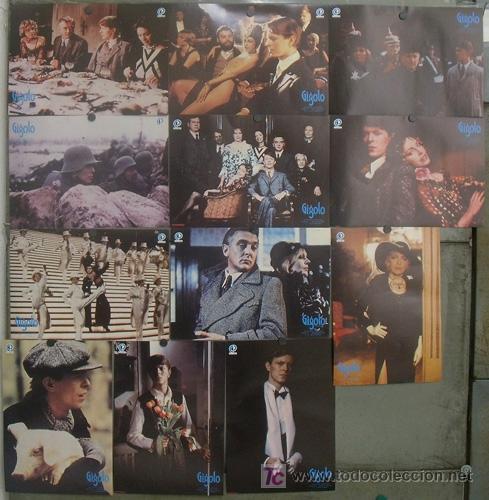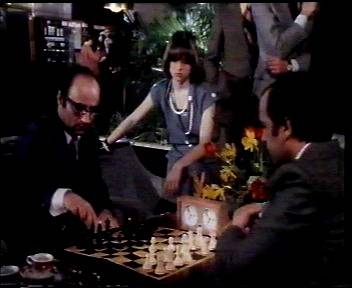From The Soho News (May 6, 1981). — J.R.
Impostors
Just a Gigolo
Black and White Like Day and Night

“All bourgeois dreams end the same way. Marry royalty and escape.” — Chuckie (Charles Ludlam) in Impostors
April 20: It’s a pity that Mark Rappaport: The TV Spinoff, which Channel 13 revives shortly after midnight, only a day before I attend a press show of Rappaport’s Impostors (playing at the Art through Tuesday), won’t be seen by everyone who’s encountering this filmmaker’s original, unsettling work for the first time. As a very witty précis of what watching (and financing and making) his movies can be like, I doubt it could be much improved upon. At the outset, when Rappaport is trying out different kinds of music with different movie stills — just a formal variation, really, of his subsequent tryouts with different costumes, backdrops, front-projections, plots, characters, clips, and raps about his movies — he’s already setting up the paradoxical parameters of his glamorously homemade cinema.
It’s a place where the writer-director and his resourceful actors and crew are all studiously working their asses off to furnish the audience with a kind of do-it-yourself melodrama kit, at once firmly overdetermined and subtly undermined — full of hysteria and intrigue, signifying everything. Rappaport is interested in props and scenic designs, he explains at one point, “not to recreate reality but to suggest a different one.” It’s no wonder that he’s respected more and known better in Europe than in Fun City, where the zeitgeist often seems like the only game in town.
Rappaport fills most of his movies with enough old-fashioned plot to support an entire course in nineteenth-century fiction, and enough bitchy dialogue to stuff Joseph Mankiewicz’s closet (“Actually, there’s not much difference between being dead and being in Vermont, if you know what I mean”), simulates opulence in his studio sets and class in his talented cast. He then uses these elements in part like filtering screens, each of which emotionally and effectually blocks off a portion of all the others. The results of this elegant, intricately tortured process can be humorous and entertaining as well as creepy and uncomfortable. The dramas turn out to be at once so florid and so private that they can improbably suggest a full-scale opera staged at the bottom of a well, or 2001 seen on a bite-size TV screen.
April 21: Impostors isn’t my favorite Rappaport film — I’d assign that place to the 1977 Local Color — but with a $115,000 budget and an all-star cast, it’s probably the most lavish, in thought as well as deed. (I should add that, having watched a fair amount of the shooting two summers ago for a American Film production story, I find it more interesting than I might have otherwise.) The daisy-chain of flirtations, passions, jealousies, relationships, and correspondences between a well-to-do romantic hero (Peter Evans), a pair of murderous magicians impersonating a pair of murdered twins (Charles Ludlam and Michael Burg), their mysterious assistant (Ellen McElduff) and her mysterious soulmate (Lina Todd), are so complexly interwoven that after a while, döppelgangers start to proliferate like bunny rabbits.
Each couple and/or two-way pattern threatens and comments on every other, so that straight and gay sensibilities, male and female characters, and passive and aggressive roles seem perpetually at loggerheads with one another, fighting their way through insults and betrayals into bitter, neurotic stalemates. What’s even stranger is that all the males seem at times like different facets of the same personality — a characteristic that this movie shares with two of its pointed thematic reference points, Proust’s La Prisonnière and Hammett and Houston’s The Maltese Falcon.
A lot of the time, it’s difficult to know whether to laugh or scream; and like certain other obsessive directors, Rappaport often tries to have it both ways — keeping the viewer distanced and testily daring the viewer to get involved and/or pissed off at the same time. Ludlam, in particular, is a superb needler who works with macabre camp as if it were a delicate instrument, stretching out his cackling effects into cadenzas.
“So many corpses, so little treasure!” wails Burg, the other weirdo magician in the movie; he could just as well be talking about the diverse deadends and rewards of narrative itself. To say that Impostors doesn’t “work” finally isn’t to say much at all. Louis Malle’s Atlantic City works like a charm, but leaves me with next to nothing afterward — like a good meal you forget about the following day, or a Jacques Demy movie that makes you feel pleasantly nostalgic about your own dreamy narcissism.
Impostors, a good deal stickier, leaves me with something more, some of which I don’t know what to do with. This is the third time I’ve seen it over the last couple of years; it looks better now than it did, but it still drives me a little batty (as it no doubt should). To my taste (ethics plus erotics), the women in the movie are too elliptical and remote, the Evans character too well armored against ridicule, and the dialogue too doggedly flashy in spots. (One character compares love and romance to an artichoke —“you peel it all away, and there’s nothing left” — when what she or Rappaport apparently means is an onion.)
But there’s a lot more rattling around inside the possibilities of this oddball romantic epic than one can find in most places, and filmgoers who like to take (and honor) bold risks should give this movie a chance. You might wind up hating it; but even if you do, you’ll probably have some interesting reasons. And either way, I can guarantee that you’ll have plenty to look at, listen to, and think about: the fact that Rappaport has a good eye, ear, and mind already places him well ahead of most of contemporary cinema.
April 27: Just a Gigolo (1978), now at the Eighth Street Playhouse and the D.W. Griffith — directed by the English actor David Hemmings, mainly set in Berlin during the 20s, and reportedly the most expensive movie made in Germany since the war — calls to mind Eisenstein’s regretful description of Viktor Shklovsky: a string of pearls without the string. To be fair, though, several empty oyster shells have also been tossed in, apparently for maximal weight and clatter.
The pearls include David Bowie, Marlene Dietrich, Hemmings, Kim Novak, and Sydne Rome (a sexy American actress who works abroad, and played the lead in Polanski’s underrated and neglected What?), not to mention a certain amount of genuinely lush decor and lurid atmospherics — and an opening virtuoso crane over and around what feels like a good quarter mile of WW1 trenches. What makes these pearls fall all over the place and clutter up the screen, and ultimately seem about as artfully arranged as a dropped bag of jelly beans, is the conspicuous failure of any unit of thought, time or space to string all of it (and us) together. I’m afraid that includes Bowie, a marvelous nonactorly film objet in The Man Who Fell to Earth who can’t project an interesting or convincing continuity across the chasms that separate the set pieces here.
About half an hour shorter than its original version, Just a Gigolo drifts along in uneven slabs, and it’s impossible to tell how much of this is due to Ennio de Concini and Joshua Sinclair’s script and how much is lost through editing. The filtering out of certain effects, as described above in Impostors, seems to operate here as well, but this time by default rather than by design — in part through the confused handling of lapsed time between sequences — so that what results is not so much a battle of wills as a dispersal of ideas. With everything going everywhere, nothing ever gets anywhere, as it becomes increasingly apparent that the movie is, in effect, merely standing still and grinning at you, trying to leer and get you to leer back.
With an episodic plot rich with comic book props –a gigantic, bottle-shaped sandwich board worn by Bowie; a secret Nazi HQ led by Hemmings that’s housed a la Superman in an abandoned subway car — and predictable conceits (like Dietrich, a madam with a stable of gigolos, singing part of the title tune after hours, Cabaret-style), most of which comes across like a parody of Billy Wilder’s boyhood, Just a Gigolo merely starts and stops, the starts again, like a machine or toy fitfully going berserk.
Ever since I accidentally stumbled into her brief, uncanny cameo in the otherwise dreadful The White Buffalo (1977), I’ve been waiting to see Kim Novak again, and she doesn’t let me down — even in an absurd scene that shows Bowie recoiling from her voluptuous enticements for reasons I cannot even begin to fathom. But Dietrich’s bit from behind a veil is so self-consciously “tailored” to her talents that it becomes sadly unmemorable for precisely that reason — aiming to blend in with the woodwork of our petrified memories and cliche banks, and succeeding all too well.
The erudite Elliott Stein informs me that the death and subsequent glorification of the Bowie character at the end is clearly influenced by Horst Wessel, a 21-year-old pimp and gigolo brownshirt, in love with a prostitute, who was killed in a nonpolitical streetfight and made into a Nazi martyr — celebrated in a famous Nazi song that set his poem “Raise High the Flag” to cabaret music. An interesting movie might have been made about all this, I suppose, but in this case the tail end of the idea merely gets stitched clumsily onto a lot of other incomplete gestures and half-hearted forays. “Marry royalty and escape” indeed: this kind of moviegoing shows you how somebody like Cimino can spend a wad, go for broke, and lose all that wonderful sense of proportion that underlies the low-budget extravagance of a Rappaport.
***
April 29: A surprisingly well-made and engrossing movie about a less than promising subject, Wolfgang Petersen’s Black and White Like Day and Night (1978), a West German movie at Cinema Studio, is only 103 minutes long –- a near-miracle of economy these days. It’s about a self-made chess genius named Thomas Rosenmund (the best Bruno Ganz performance I can recall seeing) who drives himself mad pursuing and maintaining his world-champion title (along with showy sidebar stunts, like playing 60 games at once blindfolded, and losing only four — which puts him in the hospital). I’m not sure how Petersen, Ganz, and scriptwriters Jochen Wedegartner and Karl-Heinz Willschrei keep this going as well as they do, but suspect that concentration, in all its meanings, has a lot to do with it, as it has a lot to do with chess.
The problem is this chess is an essentially unfilmable game, like poker, in part because both these games depend on real time. Movies, on the other hand, have to get along on elliptical movie time, where all spectators have to share the same amount of time (very democratic) puzzling out what’s going on at any given point — which is usually never enough time, anyway, because the freedom we have to scan movies rather than simply “read” them discourages and inhibits disciplined work like analyzing a board strategy. Consequently, chess buffs are bound to be as frustrated as prizefight fans are at Raging Bull.
It’s tempting to imagine a split-level, multi-image movie that could speak to both constituencies at once. If a Norman Mailer can situate a “scene scoreboard” next to the stage in his play of The Deer Park, and John Waters can signal appropriate smells in Polyester with Pavlovian numbers in the bottom right-hand corner of certain shots, why couldn’t a filmmaker similarly include a diagram of a chess game while he’s trying to exploit the scene dramatically in other ways? There are hints of that approach here when we see the hero playing his Russian adversary in a theater complete with box seats, a gigantic Big Brotherish video screen projecting a board diagram of their ongoing game behind them. Even though we can’t assimilate the contexts of their moves, the general idea of Projected Thought is so strong — and as neatly decorous as the film’s title, or the recurring crane shots around the hero’s house in the snow — that it makes the developing madness oddly at one with the everyday madness of cinema.


Like Alain Jessua’s Life Upside Down, this movie is so leisurely about its exposition of its hero’s insanity that it works like a spell, slowly drawing you into the mysticism of nicely staged encounters. The existential and Zen notions of combat so common to Westerns, “Easterns,” and movies like The Hustler are delineated and distanced at the same time. Eventually, the hero’s psychic deterioration, paranoia included, seems indistinguishable from his purity of purpose — reflected in his attachment to large pawns and tiny kings, and his bold challenge to God for a match (”You take white, I’ll give you a pawn”), which he dictates to his wife. For all intents and purposes, this bourgeois dream ends the same way as the others — inside someone’s head.
Suggested for further kicks: The Hardboiled Hollywood series at the Harold Clurman Theater, where you can catch two versions of The Maltese Falcon this Sunday (1931 and 1941) to compare with Rappaport’s acerbic variations. And stay tuned at the same theater for the fabulous Outlaw Cinema series, ranging from Bunuel and Browning to Romero and Russ Meyer, that starts May 24.
Published on 19 Aug 2011 in Notes, by jrosenbaum
This entry was posted on Friday, August 19th, 2011 at 3:20 am and is filed under Notes. Follow the comments through the RSS 2.0 feed. Both comments and trackback are closed.

